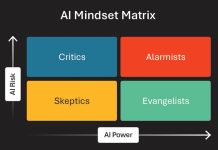ADNAN ZIJADIC, director analyst at Gartner, predicts that within four years, 60% of b2b seller work will be executed through conversa- tional user interfaces via generative AI sales technologies, up from less than 5% currently. We spoke with Zijadic recently about his report, “Multidimensional CRM: How GenAI Will Revolutionize Sales Force Automated Platforms.” The full conversation can be heard on our podcast. Here are some of the highlights of that conversation.
SMM: Collecting and analyzing prospect data has been around for a decade or more. If there is a thesis sentence to your report, it’s that generative AI is a game-changer when it comes to how sales organizations capture, understand and utilize data. Is that right?
AZ: It’s important to know that this is a cascading effect from the standpoint of every part of the sales process will be complemented in some aspect by the ability to retrieve data and, in effect, to drive overall sales decision intelligence. This allows you to then revisit how you do deal planning, where and how you allocate resources. It’s really a fundamental shift in how you use technology as a teammate versus as just simply a tool. It’s working alongside you — and for you — versus something that you do to just get through, whether it’s a process or just your day-to-day tasks.
SMM: That “teammate more than a tool” statement is repeated a few times in the report. Can you explain it further?
AZ: In the last decade or even beyond, sales tools and technologies were always seen as just another thing a seller, a manager or leader uses to get their work done; it really didn’t exist as a means to fully augment the work you do. Technologies of the past were largely a hit or miss on the scale of efficiency. You now have a piece of technology in generative AI that finally has a general sales purpose. It’s not just summarizing meeting notes and extracting relevant information about them. It will collect data on ideal customers and summarize. It’s actually going out and doing some of the prospecting for you — two completely different aspects of a sales process done by a single piece of technology. That’s what I would consider a teammate!
SMM: What’s the comfort level of sales managers, chief revenue officers or sales enablement teams with this titanic shift and this huge transition coming their way?
AZ: There is definitely a low level of maturity from an understanding standpoint. A lot of the discussions are just becoming more knowledgeable about these tools and not just jumping into this. We usually try to recommend having a delicate balance in terms of starting with small pilots.
SMM: Ahead of this conversation, I shared a recent Harvard Business Review article by a London-based marketing professor who wrote about the possibility that generative AI has reached its peak. He raises the concern that future AI models may predominantly train on their own outputs and become AI echo chambers rather than evolve. Also, there is the ubiquitous concern that AI removes the human element and authentic human creativity from sales, which is a very human endeavor.
AZ: There is always a potential for overreliance and misuse. This is where organizations have to set boundaries and implement proper training programs. It’s crucial to recognize that the goal is not to eliminate the human element from the sales process, but to actually enhance it. Skills that are distinctly human will remain as such — building relationships, understanding complex customer needs, even how you qualify a lead — because that requires some contextual understanding. Its success hinges on a balanced partnership with human insight and oversight. That’s where I think the synergy is. It’s leveraging both the strength of AI where it’s great and human intelligence for more effective and ethical sales practices.
SMM: One of your recommendations in the report is to design a comprehensive roadmap. Who within a company should take the lead on that?
AZ: Sales enablement is probably first, but sales ops and sales enablement need to work in tandem. One, because they can. There’s a synergy in terms of understanding what gen AI or AI is; what it’s not; how to use it effectively; how to think critically about the type of input you impart and the structure of that input but also the output and not just take its persuasive tone for facts. That’s the part that goes into some of the fabrications that it can espouse and some of the hallucinations if we want to call them that. The other part is just breaking down sales processes into tasks; knowing when and where to augment with AI. Shockingly, there’s little to no alignment to any sales objective whatsoever. Improving productivity is not a sales objective per se, but a means to a specific objective or a facilitator of specific objective such as increasing revenue.
Designing a comprehensive roadmap is just being able to discern where to measure to understand the effectiveness of AI.
SMM: Another recommendation is to exercise due diligence when evaluating vendors’ claims regarding generative AI capabilities. What should raise red flags?
AZ: If it sounds too good to be true, it probably is. With vendors, you want to understand what their vision for the future with AI is. Does that align with yours? What is their cost model? What are their security and privacy control mechanisms and governance structure? What kind of mechanism exists for having control of your data and what the model that they are trying to sell you trains on?
Listen to the full podcast interview here.





